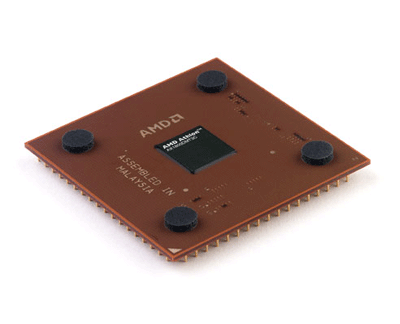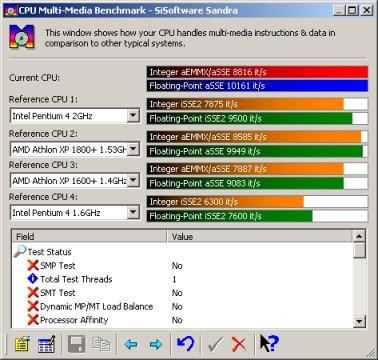|

Introduction
The time period between the release of the Athlon XP1800 and this new chip, the 1600Mhz XP1900 can be measured in days. Indeed, the initial AthlonXP range which included the XP1800 was unleashed on the world on October 9th, therefore it's less than a month since the debut of the lineup.
Those souls that have been overclocking these new line of processors have discovered that the vast majority of XP1600's all the way to the 1.533Mhz XP1800 all pretty much do 1.6Ghz without much effort. So it's not surprising that AMD have decided to release the next speed grade in the XP series and spawn a new flagship processor.
While it's only a 66Mhz increase in clock over the XP1800, matching to a half point increase in the multiplier (12x vs 11.5x on the XP1800) it corresponds to a 100Mhz increase in the speed of a Thunderbird core needed to match it's performance, hence the new rating.
So what lets AMD get away with the 100 point jump in PR rating and only a 66Mhz increase in clock? Lets revisit Quantispeed for a second. Quantispeed is the enhancements to this new core that give the 4/MP/XP core it's new found speed. Here's a quick rundown.
- Enhancement to the CPU pipeline, increasing IPC (Instructions Per Clock)
- Floating point unit enhancements to make it the quickest ever x86 FPU
- Hardware data prefetch meaning the CPU is intelligent enough to guess what data it might need next
- Modifications to the Transition Lookaside Buffers for better use of on chip L1 and L2 cache memory
Those enhancements make the new core into the Thurderbird beater it is and allow AMD to legitimately use their new PR rating. It may not go down well with some, but it's easy to match XP rating to true clock and those in the know shouldn't be bothered at all. For the consumer, it makes sense to me since they like the big numbers and something they can use to compare 2 systems, be it a valid comparison or not.
Price and Performance
Most of the questions surrounding the XP1900 will settle on it's performance since we've covered the new Quantispeed stuff during the arrival of the original range. We know what makes it tick, but does it tick fast enough to warrant buying one over an XP1800? It helps to consider price here. In the UK at the time of writing, the new processor was a whopping ~£251 while it's predecessor retails for ~£191. Does the speed boost warrant spending £60 for 66Mhz? That roughly speaking £1 per extra Mhz. Not very good since for that to weigh out for the whole CPU, an XP1900 would cost near £2000.
So it doesn't compete on price for the extra raw speed you gain. Lets see how that raw speed takes shape when applied to our synthetic benchmark suite, Sandra.
Just briefly, a quick look at the test bed:
- AMD Athlon XP1900+ Processor
- EPoX 8K7A Motherboard (AMD761 + VIA 686B)
- 256Mb Crucial PC2100 DDR
- Asus V8200 Deluxe GeForce3
- Adaptec 39160 Dual Channel U160 SCSI
- 2 x 73Gb Seagate Cheetah U160 10,000rpm disks
- SBLive!
- Netgear FA310TX PCI NIC
First off, the CPU Arithmetic bench:

Here we see the 1600Mhz processor take the expected lead over the reference CPU's in this new unreleased version of sandra that will be hitting the mainstream very shortly. Nothing exciting to see, just the numbers in the right places.
Next up, the CPU Multimedia Bench:

Here we see Sandra making full use of the SSE available on the XP1900 to give us the fastest CPU multimedia bench yet witnessed on a stock AMD processor in our labs. The results fall into line as expected.
Finally the Memory Benchmark. Before I show you the numbers, this new version of Sandra calculates the memory benchmark figures differently from all previous versions. It makes extensive use of data prefetch and buffering (not the data prefetch in Quantispeed, but it's own algorithm), uses buffering which is a common technique in memory intensive applications to ensure a steady flow of data and uses extra instruction sets like SSE heavily.
Therefore using the the new Sandra, the current AMD processors and supporting chipsets turn out numbers a lot closer to the current leader in Sandra's memory bench, the P4 + i850(RAMBUS) combination. This reflects a real world situation where while the P4 + i850 has phenomenal memory bandwidth, it doesn't give it a huge lead that the Sandra numbers might indicate. These new numbers are more indicative of real world performance.

Here we see the lowly (given that KT266A and nForce are out and about, eclipsing AMD's flagship desktop chipset) EPoX 8K7A motherboard, sporting the much loved AMD761 + VIA 686B combo and the new processor. It manages to provide nearly 2Gb/sec on both the integer and floating point tests and it compares favourably with the ~2.17Gb/sec that the P4 and i850 offer.
These new Sandra numbers will become commonplace as soon as sites update their copies when the new version is released and you'll see a closer match between AMD and Intel system as far as the memory bench is concerned. We're happy to show you numbers from this beta version of Sandra as Adrian, the Sandra author notes that the beta we used was a genuine release candidate for the next stable version and the numbers will not change significantly.
As a final point of reference, I've seen in the Labs a 1.2MP running @ 1548Mhz (172Mhz FSB) on an EPoX 8KHA+ (KT266A) and giving memory benchmark numbers of 2607 ALU / 2365 FPU, overtaking the P4 by a large margin. However, that's on a heavily overclocked system, but shows the potential performance of such a system running that FSB.
As far as running other benchmarks on this processor, with it coming so soon after XP1800 and offering a measly 66Mhz extra speed for so much more extra money we instead point you to our XP1800 review where you can guage the overall performance of the class leading AMD CPU's. The performance of the new XP1900 will be roughly 3-6% more than the XP1800 in the same benchmarks. Check it out here. Then decide if the 66Mhz for £60 is worth it to you and make your purchase based on that.
While we must applaud AMD for once again raising the x86 bar, with CPU's this fast and for the price premium I don't see the 1900XP as an attractive purchase. For those with no care for money, buy it without hesitation since it's without question the quickest x86 processor that money can buy.
For everyone else, hold off until prices come down. The slower chips in the range aren't slow by nature, just slower by clock. All the CPU's are commendable performers and you should choose the CPU that fits your needs and budget. However, with it being the best x86 CPU money can by and looking at it with it's technical merits, we're again awarding the XP1900 the Hexus Editors Choice Award. A commendable speed grade increase from AMD. Well done again.

|